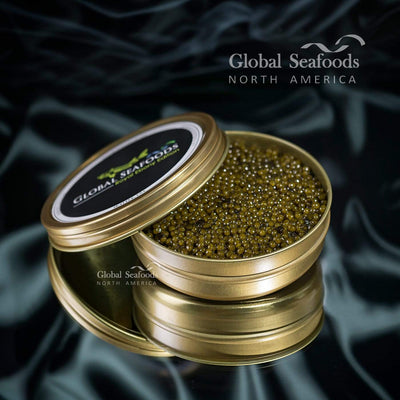The Luxurious Taste of Kaluga Caviar: Why It's a Must-Try Delicacy

The Irresistible Taste of Kaluga Caviar: A Gourmet's Delight
Kaluga caviar, often referred to as "river beluga," is one of the most celebrated delicacies in the culinary world. Renowned for its large pearls, creamy texture, and nutty flavor, Kaluga caviar provides an indulgent experience for gourmets worldwide. This guide delves into the origins, taste, production, and best ways to enjoy this sought-after treasure.
What is Kaluga Caviar?
Definition and Origins
Kaluga caviar is derived from the Kaluga sturgeon, a species native to the Amur River basin on the border of Russia and China. Known for its massive size, the Kaluga sturgeon can weigh up to 2,200 pounds, producing some of the most exquisite caviar in the world.
- Egg Characteristics: Large, glossy, and dark gray to black pearls.
- Taste Profile: Buttery, nutty, and slightly sweet, with a rich, lingering finish.
Why is Kaluga Caviar Special?
The Kaluga sturgeon’s unique habitat in freshwater and semi-saline environments contributes to the unparalleled quality of its roe. Its slow maturation process (up to 20 years) ensures that the caviar develops complex flavors and a luxurious texture.
How is Kaluga Caviar Produced?
Egg Harvesting Process
Kaluga caviar is harvested with precision and care. Female sturgeons are raised in controlled aquaculture environments, ensuring both the health of the fish and the quality of the eggs. Harvesting involves:
- Gentle Extraction: Ensuring minimal stress to the fish.
- Meticulous Cleaning: Eggs are washed to remove impurities.
- Light Salting: Enhances the flavor while preserving the caviar.
Commitment to Sustainability
Sustainability is at the core of Kaluga caviar production. Farms implement non-invasive techniques and release fish back into the wild post-harvest. This practice helps conserve sturgeon populations while meeting global demand.
For sustainable options, explore White Sturgeon Caviar.
The Unique Taste and Texture of Kaluga Caviar
Flavor Profile
Kaluga caviar delivers a symphony of flavors, blending:
- Creamy Butteriness: A melt-in-your-mouth sensation.
- Subtle Sweetness: Balances the richness perfectly.
- Nutty Undertones: Adds depth to its luxurious taste.
Texture
The pearls of Kaluga caviar are larger than most other types, creating a satisfying pop when eaten. This texture, combined with its creamy finish, makes every bite an indulgent experience.
How to Serve and Enjoy Kaluga Caviar
Serving Tips
- Temperature: Always serve chilled, ideally between 28°F to 32°F (-2°C to 0°C).
- Presentation: Use a mother-of-pearl spoon to preserve its flavor and present it on a bed of crushed ice for elegance.
Pairing Ideas
Kaluga caviar pairs beautifully with a range of foods and beverages:
- Classic Pairings: Serve atop blinis or toast points with crème fraîche.
- Beverages: Pair with dry champagne, crisp white wine, or premium vodka for a luxurious experience.
For a more adventurous pairing, try it with Russian Ossetra Sturgeon Caviar.
Culinary Uses of Kaluga Caviar
While Kaluga caviar is exquisite on its own, it can elevate many dishes:
- Garnish for Seafood: Adds elegance to oysters, scallops, or smoked salmon.
- Pasta and Risotto: A dollop of caviar transforms simple dishes into gourmet masterpieces.
- Deviled Eggs: Mix with egg yolks for a sophisticated twist.
FAQs About Kaluga Caviar
Why is Kaluga caviar expensive?
The slow growth and maturation of Kaluga sturgeon, coupled with sustainable farming practices, contribute to its high cost.
Can I freeze Kaluga caviar?
Freezing is not recommended as it alters the texture and flavor. Always consume fresh or store in the coldest part of your refrigerator.
How long does Kaluga caviar last?
Unopened, it can last up to two months in the refrigerator. Once opened, consume within 48 hours for optimal freshness.
Comparison: Kaluga Caviar vs. Other Types
| Feature | Kaluga Caviar | Beluga Caviar |
|---|---|---|
| Egg Size | Large, up to 3.5mm | Largest, up to 4mm |
| Flavor | Buttery, nutty, and slightly sweet | Creamy, delicate, and rich |
| Texture | Firm with a creamy finish | Silky and smooth |
| Sustainability | Highly regulated farming | Limited due to conservation laws |
Conclusion
Kaluga caviar is more than just a delicacy; it’s a testament to the artistry of sustainable aquaculture and gourmet excellence. Its rich, buttery flavor, coupled with its velvety texture, makes it a must-try for any food enthusiast. Whether served simply with toast points or paired with champagne, Kaluga caviar promises a luxurious experience.
For those eager to indulge in this gourmet delight, explore premium selections such as Kaluga Caviar and Siberian Sturgeon Caviar.
Discover more culinary inspiration on our YouTube Channel.
Also in News

How to Make Sea Bream Sushi With Dry-Aged Tuna & Crab Roll — Step-by-Step With Chef Joshua
A complete guide to making Sea Bream sushi at home, including filleting, curing, slicing, and building a Dry-Aged Tuna & Crab sushi roll. Chef Joshua shares professional tips for restaurant-quality results.

Boiled Crab for Game Night: Everything You Need for a Perfect Seafood Party
Take your game night to the next level with a Boiled crab party. Learn the best recipes, cooking tips, and hosting hacks for a memorable seafood feast.

Boiled Crab for Date Night: A Romantic Guide to the Perfect Seafood Feast
Make your next date night unforgettable with a romantic Boiled crab experience. This guide covers everything you need to know, from ambiance to the best crab varieties.

